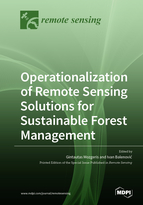Operationalization of Remote Sensing Solutions for Sustainable Forest Management
A special issue of Remote Sensing (ISSN 2072-4292). This special issue belongs to the section "Forest Remote Sensing".
Deadline for manuscript submissions: closed (30 November 2020) | Viewed by 66649
Special Issue Editors
Interests: geomatics; forest management; environmental policy
Special Issues, Collections and Topics in MDPI journals
Interests: forest inventory; photogrammetry (airborne, unmaned aerial systems); LiDAR (airborne, unmaned, terrestrial, mobile, personnel hand-held systems)
Special Issue Information
A pre-requisite for sustainable management of natural resources is the availability of timely, cost-effective and comprehensive information of the condition and development trends of the specific resource. Remote sensing has always been an essential source of such information. Specifically, forestry has long benefited from these techniques: the literature on analytic algorithms for forest areas based on remotely sensing data is abundant. Nonetheless, the operational applicability of research results needs to be improved. Moreover, remote sensing researchers often seek purely academic objectives, lacking the support and quality guidance from practical forest management objectives. Thus, science-driven solutions for knowledge transfer between researchers and forest stakeholders/policy makers/end users are becoming increasingly important.
With this Special Issue, we aim at compiling research papers dealing both with remote sensing methodologies and the implementation of research results to facilitate sustainable forest management. The focus is placed on remotely sensed data, the development of algorithms for forest site characterization, wood characterization, biomass and CO2 stocking, mapping forest conditions, ecosystem vulnerabilities, socioeconomic functions and conditions, as well as on operationalization of remote sensing for natural resource management through the integration of scientific research and its practical utilisation. Overall, we call out for contributions combining remote sensing and any of the targets of the 2030 strategic research and innovation agenda for the forest based sector. Review contributions are also suitable for the Special Issue.
This special issue is linked with H2020 project MySustainableForest, however, contributions from other researchers are very welcome.
Prof. Dr. Gintautas MozgerisDr. Ivan Balenović
Guest Editor
Manuscript Submission Information
Manuscripts should be submitted online at www.mdpi.com by registering and logging in to this website. Once you are registered, click here to go to the submission form. Manuscripts can be submitted until the deadline. All submissions that pass pre-check are peer-reviewed. Accepted papers will be published continuously in the journal (as soon as accepted) and will be listed together on the special issue website. Research articles, review articles as well as short communications are invited. For planned papers, a title and short abstract (about 100 words) can be sent to the Editorial Office for announcement on this website.
Submitted manuscripts should not have been published previously, nor be under consideration for publication elsewhere (except conference proceedings papers). All manuscripts are thoroughly refereed through a single-blind peer-review process. A guide for authors and other relevant information for submission of manuscripts is available on the Instructions for Authors page. Remote Sensing is an international peer-reviewed open access semimonthly journal published by MDPI.
Please visit the Instructions for Authors page before submitting a manuscript. The Article Processing Charge (APC) for publication in this open access journal is 2700 CHF (Swiss Francs). Submitted papers should be well formatted and use good English. Authors may use MDPI's English editing service prior to publication or during author revisions.
Keywords
- Earth observation
- forestry
- characterization of forests
- operationalization of remote sensing algorithms
- knowledge transfer







